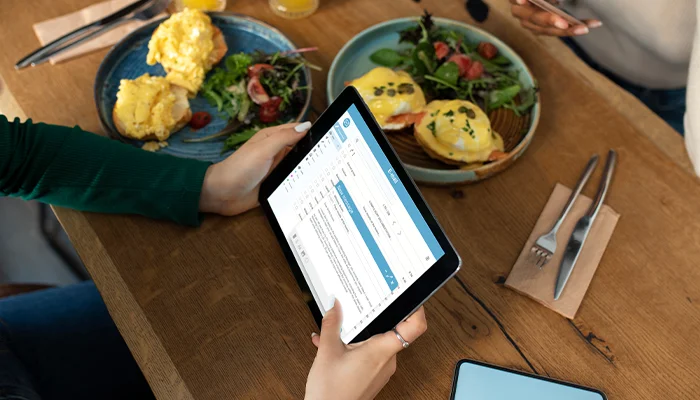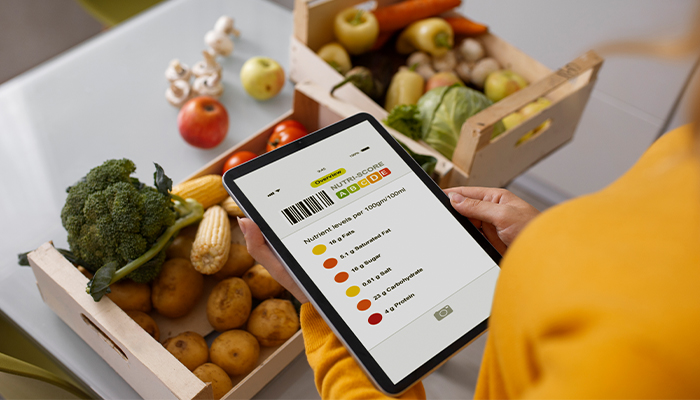Advantages and Disadvantages of the Online Food Ordering System

JAN, 03, 2024 03:25 PM
Advantages and Disadvantages of the Online Food Ordering System
The dynamic landscape of the food ordering industry is undergoing rapid transformation. For restaurant proprietors, venturing into the online realm is imperative to broaden their existing customer base and augment revenue streams.
The inception of food ordering can be traced back to World War II, when women volunteers initiated a system to deliver hot, pre-cooked meals to those affected by the war. Since then, this concept has evolved significantly, culminating in the sophisticated form we witness today through the prevalence of food ordering applications. Now, anyone with a smartphone or tablet can conveniently place food orders online.
Recent statistics from an NRA report indicate that a substantial 74–75% of millennials express a preference for online food ordering. This shift in eating habits, coupled with the rapid integration of technology, is reshaping the food market at an unprecedented pace.
The digitization of food distribution not only facilitates faster transport with reduced human contact but also opens up a realm of opportunities for restaurant owners contemplating the adoption of an online food ordering system. Understanding the myriad advantages and disadvantages associated with this digital transformation is crucial for those considering making the leap into the online food ordering system.
Advantages
Enhanced business flexibility and profitability:
Implementing and managing an online food ordering system not only introduces a heightened level of operational flexibility but also serves as a catalyst for the augmentation of sales and overall profitability within the business structure. This newfound flexibility extends to various facets of the operation, from menu adjustments to promotional strategies, allowing for agile responses to market demands and trends.
Convenience and Speed:
The prevalence of online food ordering is underscored by the unparalleled convenience and speed it offers consumers. This mode of culinary procurement has become an ingrained aspect of modern living, particularly with the technologically adept millennial demographic. The ease of navigating digital platforms and the rapidity with which orders can be placed make it an exceptionally accessible option, rendering it virtually at the fingertips of those seeking swift and efficient culinary solutions.
Health Benefits:
Beyond mere convenience, online food ordering systems actively contribute to the promotion of health-conscious choices among consumers. The provision of thoughtfully planned meals, coupled with features such as calorie tracking, becomes a valuable tool for individuals embarking on weight-loss journeys or those committed to maintaining a well-balanced and nutritious diet. This intersection of technology and health consciousness establishes online ordering as a holistic solution to dietary needs.
Safety and health compliance:
In the current landscape, where health concerns are paramount, the transition to online food ordering aligns seamlessly with stringent health and safety regulations. By offering a contactless alternative, these systems provide customers with a secure means of culinary enjoyment while mitigating the risks associated with in-person transactions during the ongoing pandemic, thus contributing to the collective effort to curb the spread of COVID-19.
Reduced Chance of Errors:
The implementation of online ordering systems significantly diminishes the probability of billing errors, ensuring a high degree of accuracy in pricing and an impeccably streamlined ordering process. This meticulous approach not only fosters customer satisfaction but also eliminates potential discrepancies that may arise in traditional ordering methods, thereby fortifying the reliability of the entire transactional experience.
Expanded customer base and loyalty:
A well-crafted and seamlessly executed online ordering system functions as a potent tool for customer acquisition and retention. Beyond merely attracting new patrons, these systems have the capacity to cultivate and nurture customer loyalty through the implementation of personalized offers, exclusive promotions, and targeted engagement strategies. This, in turn, fosters a sense of allegiance among the customer base, promoting repeat business and sustained revenue streams.
Increased consumer spending:
The transition to online ordering not only facilitates informed decision-making but also positively influences customer spending behaviors. In the digital realm, customers are afforded the luxury of time to peruse comprehensive menus, consider various options, and ultimately place larger orders. This heightened engagement often translates into increased spending, presenting a lucrative opportunity for businesses to capitalize on the evolving dynamics of consumer preferences.
High Customizability:
The adaptability and customizability inherent in food ordering apps empower businesses to sculpt a unique and visually appealing digital presence. Beyond the mere functionality of menu updates, these platforms offer extensive customization options, allowing establishments to showcase distinctive branding elements, incorporate visually appealing graphics, and seamlessly integrate any modifications to the menu. This dynamic customizability contributes to creating a distinct and memorable online identity for the business.
Disadvantages

Cost Considerations:
The financial implications associated with certain online food ordering systems can pose a substantial drawback, particularly for individuals constrained by a stringent food budget. The expenditure involved in utilizing these platforms may present a considerable hurdle for those seeking more economical culinary options, thereby necessitating a thoughtful evaluation of the overall cost-effectiveness for users with financial constraints.
Limited Menu Options:
Some platforms exhibit a constraint in menu diversity, with infrequent alterations that may result in monotony for users engaging with these systems over an extended period of time. This limitation in the variety of offerings could potentially diminish the overall appeal and allure for long-term patrons, prompting a desire for more dynamic and varied culinary choices to sustain continued interest.
Preparation Time:
The delivery of frozen food by these online systems may demand a significant investment of time for preparation, thereby impacting the overall convenience promised by the service. The extended preparation period required for these frozen items introduces a factor that users must consider in terms of planning and time allocation, potentially affecting the seamless and expeditious experience initially envisioned.
Quality of Food:
The quality of delivered food may undergo deterioration due to the prolonged duration of transportation, leading to potential nutrient loss and a diminished visual appeal, particularly when packaged in plastic materials. This compromise in the quality of the delivered cuisine raises concerns about the overall satisfaction of users, highlighting the need for careful consideration regarding the preservation of culinary integrity during the delivery process.
Temperature Concerns:
The extended distances covered during the delivery process may result in food arriving at its destination in a cold state, necessitating reheating on the part of the consumer. This temperature-related challenge introduces an additional layer of consideration for users who prioritize the immediate enjoyment of a warm and freshly prepared meal, potentially impacting the anticipated dining experience.
Lack of Restaurant Ambiance:
Opting for online food ordering denies customers the immersive experience intrinsic to dining in a physical restaurant setting. The absence of the ambient atmosphere, cultural nuances, and sensory elements associated with a traditional restaurant visit contributes to a potential loss of the holistic dining experience, prompting users to weigh the convenience of online ordering against the ambiance offered by brick-and-mortar establishments.
Delivery Personnel Challenges:
The individuals responsible for food deliveries may encounter various challenges, including exposure to extreme weather conditions, prolonged waiting times, and potential hazards during the transportation of orders. These challenges underscore the importance of acknowledging the external factors that delivery personnel face, with a view to optimizing the delivery process and ensuring the well-being of those integral to the successful execution of online food orders.
Health Implications:
Persistent reliance on online food ordering, especially with the allure of enticing yet less healthy menu options, raises concerns regarding potential health implications over time. The cumulative impact on health, including issues related to dietary choices and obesity, necessitates a thoughtful examination of the long-term consequences associated with frequent engagement with such convenient yet potentially health-compromising culinary alternatives.
How to Develop a Food Delivery App
Food delivery app development is a multifaceted endeavor that spans various stages, from conceptualization to execution and continuous upkeep. Below is a comprehensive guide to assist you in traversing the process of developing a food delivery app:
-
Conduct market research:
Explore market dynamics, identify target demographics, analyze competitors, and uncover potential opportunities. Highlight unique selling points that distinguish your app.
-
Specify features and functionality:
Clearly define the features your app will provide, encompassing user registration, menu exploration, order placement, payment processing, real-time tracking, reviews, and ratings. Consider extras like loyalty programs, discounts, and push notifications.
-
Select App Type:
Determine whether you want to do restaurant app development or a platform that aggregates multiple eateries. The latter often involves collaboration with various restaurants.
-
Choose the Technology Stack:
Opt for the appropriate technology stack, including programming languages, frameworks, and databases. Common choices encompass React Native, Flutter, Swift, Kotlin, and backend technologies such as Node.js or Django.
-
Wireframing and Design:
Create wireframes and design mockups to visualize the UI/UX design. Prioritize intuitive navigation, visually appealing layouts, and user-friendly design.
-
Back-End Development:
Develop the server-side logic, database, and application programming interface (API). Ensure secure data storage, efficient order processing, and seamless communication between the front-end and back-end.
-
Front-End Development:
Implement the user interface based on approved designs. Concentrate on crafting a responsive and captivating interface that enhances the overall user experience.
-
Integrate Payment Gateways:
Integrate secure payment gateways to facilitate transactions. Adhere to security standards to safeguard user financial information.
-
Real-Time Order Tracking:
Implement real-time order tracking features, enabling users to monitor the status of their orders. Utilize GPS and push notifications for accurate and timely updates.
-
User authentication and security:
Implement a robust user authentication system to secure user accounts. Ensure data confidentiality and integrity through encryption and other security measures.
-
Testing:
Conduct comprehensive testing to identify and resolve bugs, glitches, and usability issues. Perform functional, performance, security, and usability testing for a seamless user experience.
-
Launch:
Once testing is successful, launch your app on relevant app stores (e.g., Apple App Store, Google Play Store). Execute a marketing strategy to raise awareness and attract users.
-
Marketing and User Acquisition:
Develop a marketing plan to promote your app. Utilize digital marketing, social media, and partnerships with restaurants to attract users.
-
Gather feedback and iterate:
Encourage users to provide feedback, using it to make continuous improvements. Regularly update the app to add new features, enhance performance, and address user concerns.
-
Maintenance and Support:
Provide ongoing maintenance and support to ensure the app's continued functionality. Regularly update the app to stay compatible with new OS versions and address emerging security issues.
By adhering to these steps, you can navigate the food delivery app development process and create a successful UI/UX design. Remember that the app's success hinges on delivering a seamless and satisfying experience for both users and restaurant partners.
Conclusion
In conclusion, despite some drawbacks, online food ordering systems, with the help of the best mobile app development company in the USA, offer significant benefits for both customers and restaurants. The decision to embrace these platforms involves weighing the advantages against the potential downsides and ensuring a balanced approach to cater to evolving consumer preferences and market dynamics.




Strategy
Design
Blockchain Solution
Development
Launching
Testing
Maintenance
Contact US!
India

Plot 378-379, Udyog Vihar Phase 4 Rd, near nokia building, Electronic City, Phase IV, Sector 19, Gurugram, Haryana 122015
Copyright © 2025 PerfectionGeeks Technologies | All Rights Reserved | Policy
Contact US!
India

Plot 378-379, Udyog Vihar Phase 4 Rd, near nokia building, Electronic City, Phase IV, Sector 19, Gurugram, Haryana 122015
Copyright © 2025 PerfectionGeeks Technologies | All Rights Reserved | Policy

